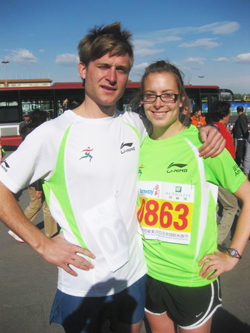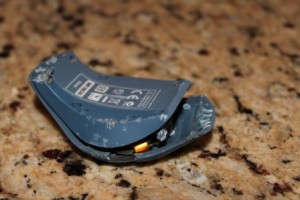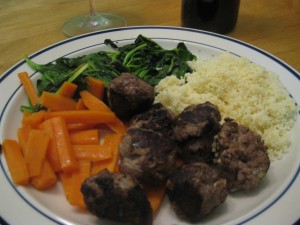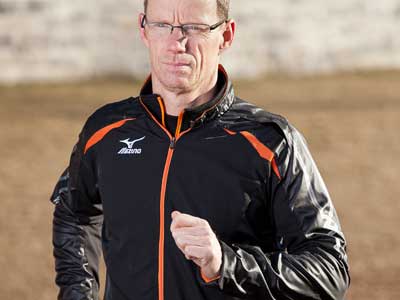By: Karen Karnis
 We would like to welcome our newest Mizuno Run Club contributors, Nikki and Nathan Reiter!
We would like to welcome our newest Mizuno Run Club contributors, Nikki and Nathan Reiter!
Nikki and Nathan are cross country coaches at the University of British Columbia (UBC) Okanagan and will be sharing nutrition and training tips, race reports, and expert interviews with the Club. To get to know this speedy couple, we sat down for a cozy Q&A.
Mizuno Run Club: What do you do at UBC?
Nikki: I’m a Laboratory Coordinator for the Health and Exercise Sciences program. I assist with undergraduate laboratory teaching. I’m also teaching first year biomechanics this term as a sessional instructor.
Nathan: Nothing! Well, I shouldn’t say “nothing”; I am coaching the Cross Country running team with my wonderful wife.
MRC: What is your educational background?
Nikki: I have a Master’s of Human Kinetics degree in Applied Human Performance with a concentration in Biomechanics.
Nathan: Compared to Nikki, I am a bit of a mixed bag. I have my Bachelor of Commerce from McMaster University, along with a Bachelor of Education from the University of Windsor.
MRC: You both have extensive experience as competitive runners. How did you get started?
Nikki: I played all sports, including track and cross country, in high school. It wasn’t until university that I decided to focus on one sport only and figured running would be my best bet.
Nathan: Similar to Nikki, I was involved in many competitive sports throughout my days, including swimming, soccer, badminton, basketball and running of course. As a youngster, I always did quite well in the endurance sports (swimming, running) so naturally I gravitated towards what I excelled at. However I didn’t get serious about running until my second year of university at McMaster.
MRC: How did you meet?
Nikki: Oh, we totally met through the cross country team at Windsor! I did my undergrad and graduate work at Windsor and Nathan came for his Education degree after spending four years on the McMaster team. We were the ‘older kids’ and soon became friends. Within the year we moved to China together and taught at a Canadian high school for two years. We just recently got married when we moved here to Kelowna. Running definitely has a strong presence in our relationship.
Nathan: Two words – “Speed Goggles”…well at least on Nikki’s part.
MRC: What are you currently training for? How many kilometres/week are you running?
Nikki: I’m currently just trying to increase my mileage and get in some solid training. That being said, I still plan to get in a few races through the Interior Running Association Road Race Series, ranging from 5 km – 10 milers. I’m usually between 75-80 km/week.
Nathan: Training for me at this stage is more about exploring alternative approaches to training to help further develop my abilities as a coach. In the past as an athlete, I was always so focused on competing and did not experiment too much with different types of training. Now being less serious about results, I am curious to add new elements that I had previously ignored and/or couldn’t handle. Presently, I am running about 70 km/week.
MRC: How did you get into coaching?
Nikki: I started off coaching my old high school track team to just help out and it gradually grew into coaching at the club and now university level.
Nathan: Coaching for me has been a natural transition after competing at the CIS (Canadian Inter-university Sport) level. While I was competing, I was always curious about the hows and whys of training. I have been fortunate to have great mentors who have facilitated my learning and have allowed me to take part in the development of my training programs. Also I often found myself in a leadership role as an athlete, whether that be as team captain or in some other capacity. So coaching has been a good fit for me to be in a position to provide guidance and to help develop other athletes.
MRC: Describe a favourite coaching moment.
Nikki: Coaching some of my high school athletes on the track, the day after their prom. They insisted they wanted a tough one and came ready to hurt. They all threw up (or were close to it!).
Nathan: I would have to say back in Hamilton where I was helping coach an elementary Run and Read Club. I loved working with these kids because they were always so pumped to run…now if only everyone shared the same enthusiasm!
MRC: What is your favourite post-workout snack?
Nikki: I love to eat good food, so this is tough. I’d have to say a juicy piece of fruit in the summer or a hot chocolate in the winter.
Nathan: I definitely do not feel bad about enjoying some good food and a premium pint. I need to replenish my strength!
MRC: Favourite reward after a race?
Nikki: Seeing a personal or seasonal best time on my watch.
Nathan: Same as above….food and a good beer.
MRC: Favourite Mizuno running shoes?
Nikki: Rider 10’s…I’ve had about 6 pairs. We’ll see if the 15’s do the job! I’m optimistic!
Nathan: The Enigma feels soooooooo good on my feet.
MRC: Favourite Mizuno apparel/accessory?
Nikki: My Performance Light Jacket – it’s got a great cut, it’s super soft and flexible, and it doesn’t feel stiff like a jacket at all.
Nathan: My Mizuno Dynamic Plus Shorts – I have these shorts that are lined with compression material….unreal
MRC: Describe a perfect run.
Nikki: I love those runs where I feel super sluggish before I leave and mid-way through I realize I could go on forever.
Nathan: Any run with my wife!
MRC: Best part about finishing a hard workout?
Nikki: Sense of accomplishment. Knowing I’m a better runner for doing what I just did.
Nathan: Any part afterwards…everything is just better…food, sleep…you name it!
MRC: What do you hope to accomplish as a coach?
Nikki: Nathan and I hope to increase the popularity of distance running here in Kelowna. There’s so much potential for training with the awesome trails, beautiful scenery and mild temperatures. We hope that UBC Okanagan develops a strong running program and eventually becomes a hotspot for runners in Canada.


 By: Karen Karnis
By: Karen Karnis

 We would like to welcome our newest Mizuno Run Club contributors, Nikki and Nathan Reiter!
We would like to welcome our newest Mizuno Run Club contributors, Nikki and Nathan Reiter!






 Our Magazine
Our Magazine Previous Release
Previous Release
